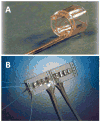Restoring standing capabilities with feedback control of functional neuromuscular stimulation following spinal cord injury
- PMID: 28215399
- PMCID: PMC5373559
- DOI: 10.1016/j.medengphy.2017.01.023
Restoring standing capabilities with feedback control of functional neuromuscular stimulation following spinal cord injury
Abstract
This paper reviews the field of feedback control for neuroprosthesis systems that restore advanced standing function to individuals with spinal cord injury. Investigations into closed-loop control of standing by functional neuromuscular stimulation (FNS) have spanned three decades. The ultimate goal for FNS standing control systems is to facilitate hands free standing and enabling the user to perform manual functions at self-selected leaning positions. However, most clinical systems for home usage currently only provide basic upright standing using preprogrammed stimulation patterns. To date, online modulation of stimulation to produce advanced standing functions such as balance against postural disturbances or the ability to assume leaning postures have been limited to simulation and laboratory investigations. While great technological advances have been made in biomechanical sensing and interfaces for neuromuscular stimulation, further progress is still required for finer motor control by FNS. Another major challenge is the development of sophisticated control schemes that produce the necessary postural adjustments, adapt against accelerating muscle fatigue, and consider volitional actions of the intact upper-body of the user. Model-based development for novel control schemes are proven and sensible approaches to prototype and test the basic operating efficacy of potentially complex and multi-faceted control systems. The major considerations for further innovation of such systems are summarized in this paper prior to describing the evolution of closed-loop FNS control of standing from previous works. Finally, necessary emerging technologies to for implementing FNS feedback control systems for standing are identified. These technological advancements include novel electrodes that more completely and selectively activate paralyzed musculature and implantable sensors and stimulation modules for flexible neuroprosthesis system deployment.
Keywords: Biomechanics; Feedback control; Functional neuromuscular stimulation; Neural prosthesis; Rehabilitation; Standing.
Copyright © 2017 IPEM. Published by Elsevier Ltd. All rights reserved.
Conflict of interest statement
Figures






References
-
- Agarwal S, Triolo RJ, Kobetic R, Miller M, Bieri C, Kukke S, et al. Long-term user perceptions of an implanted neuroprosthesis for exercise, standing, and transfers after spinal cord injury. J Rehabil Res Dev. 2003;40:241–52. - PubMed
-
- Davis JA, Jr, Triolo RJ, Uhlir J, Bieri C, Rohde L, Lissy D, et al. Preliminary performance of a surgically implanted neuroprosthesis for standing and transfers--where do we stand? J Rehabil Res Dev. 2001;38:609–17. - PubMed
Publication types
MeSH terms
Grants and funding
LinkOut - more resources
Full Text Sources
Other Literature Sources
Medical

